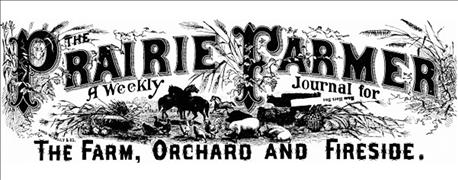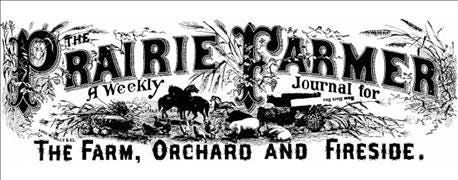
John Stephen Wright launched Prairie Farmer with one primary goal in mind: sharing best practices to help farmers improve productivity. He encouraged farmers to share discoveries and best practices — big and small — so farmers could learn from one other.
And share they did: from wine cocktails to heal a cow post-calving to keeping dogs away from the herd and insects off a new crop.
Here’s a look back at agricultural challenges and achievements from 1841 to 1899.

175 YEARS: Celebrating Prairie Farmer, 1841-2016
1841-1849: Plowing, schooling and mixing
Plowing was a hot topic in the first issues of Prairie Farmer — specifically, timing and depth on cultivated ground versus prairie land. This was the era of John Deere, who built his first plow in 1838, and manufactured 10 for sale in 1839.
Other topics included improving crop quality through corn pollination (positioning the best corn seed together), creating an ideal fence with hedge trees, and determining whether or not wheat “mutated” under certain conditions into cheat (chess) or oats.
Education was important to Wright — a child prodigy, himself — and Prairie Farmer took a very early stance on the importance of education, voicing the need for public schools.
In 1842, Illinois wheat farmers were under fire for mixing spring and winter wheat; Prairie Farmer editors threatened publishing names of guilty “mixing” parties.
1850-1859: Planting pops, fences and equipment
Planting populations and optimum planting times for clover seed and timothy seed led discussions in the 1850s. Question-and-answer columns also covered pages with topics ranging from animal ailments and potential cures to common farm challenges— like a farm dog that won’t stop chasing sheep. Prairie Farmer shared a reader’s recommendation to attach a bell to every 10th sheep to keep dogs from chasing the herd.
The majority of readers agreed that properly planted and trimmed Osage orange was ideal for fencing. Later discussions would conclude that wire fencing kept horses and cattle in check, but it wasn’t the best for hogs and poultry.
Fifteen different reapers appeared in issues from the 1850s. Steam-powered plows and two-row hand-held corn planters joined the equipment lineup by 1859.
Early drainage systems entered the scene. Prairie Farmer promoted the “twigs-in-a-trench” method as the economical option. The system was just as its name suggests: a trench with branches and/or twigs at the bottom, covered with straw and dirt. The “wooded” support system allowed enough room for water to flow through the straw.
.jpg?width=600&auto=webp&quality=80&disable=upscale)
WRITE FOR YOUR PAPER! Prairie Farmer’s original premise was a call to farmers by John Stephen Wright, editor and publisher of The Union Agriculturist and Western Prairie Farmer, known today as Prairie Farmer.
1860-1869: Civil War, new crops and a new school
The Civil War brought change to the Prairie state. Farmers who weren’t fighting in the war answered the call of duty in a different way. The government encouraged southern Illinois and Indiana farmers to produce cotton and tobacco after the North no longer received these supplies from the South. Prairie Farmer content shifted along with the new crops.
During the war, three or four pages in each issue were dedicated to letters from soldiers and war updates. War coverage ended with news of Confederate generals surrendering and President Abraham Lincoln’s assassination.
News of wartime turned to progress, especially for education. Congress passed the Land-Grant College Act in 1862. After settling on one single location, versus multiple institutions, the Illinois General Assembly selected Urbana-Champaign as home for the Illinois Industrial University — founded in 1867 and known today as the University of Illinois.
.jpg?width=600&auto=webp&quality=80&disable=upscale)
WAR STORIES: Can you imagine getting your wartime coverage once a week? Throughout the Civil War, Prairie Farmer dedicated pages to war coverage — stories of bravery and stories of loss.
1870-1879: Price gouging, fire and insecticide
After discovering railroads were charging less for a shipment from New York to Chicago than Chicago to Bloomington, Prairie Farmer encouraged farmers to organize and fight against unfair practices and monopolies. The efforts from groups like The Grange can still be found today. The Illinois Railroad and Warehouse Commission was established in the 1870s to regulate grain trading, warehouse rates and railroad shipping costs. After time and reorganization, it’s known today as the Illinois Commerce Commission.
More farmers showed interest in farm machinery: Mechanical corn planters replaced hand-planters and drills for seeding oats. Farmers got their first look at new machinery at fairs and experiment stations.
In 1871, the Great Chicago Fire destroyed building after building, including the Prairie Farmer office. Editors saved subscription books, a set of back issues and a pictorial engraving. Despite the major catastrophe, the first issue of Prairie Farmer following the fire mailed on time.
Paris green, a new insecticide, came onto the scene, followed by London purple. The insecticides — combinations of copper, sulfur and arsenic — were applied with a hand-powered sprayer. The potential harm and side effects from the products were quickly recognized, and Prairie Farmer urged housewives to thoroughly wash treated fruit or vegetables.
1880-1889: Boosting corn yields, germ tests and weather maps
In 1886, the Fat Stock Show was held in Chicago. Farmers flocked to see Prairie Farmer’s corn display, made of a few thousand ears of corn. This crowd pleaser was a sign of the times: Corn was king in the 1880s.
Farmers found corn less labor-intensive compared to potatoes, cotton and tobacco. Prairie Farmer focused its content on how to boost corn yield: selecting and preserving seed corn, properly drying down and storing the seed, and germ testing. Yields increased from 24.3 bushels an acre to 36.8 bushels an acre.
As yields improved, more corn went to feeding livestock. Farmers quickly discovered livestock gained faster with access to clean water from wells and high-quality feed.
The first weather map appeared in 1883. But Prairie Farmer soon found the hand-engraved printing plate was too time-consuming to become a regular feature. And, as you might imagine, the weather changed before the issue hit mailboxes.

WHAT FENCE IS BEST? Ideal materials, wires, patents — all things related to fencing were discussed in early editions of Prairie Farmer. Editors responded to questions over the Leavenworth patent and the J. Moore patent in the March 8, 1884, issue.
1890-1899: Livestock, soil fertility and manure
The yield advancements made in the 1880s resulted in a corn surplus. Prices dropped from 55 cents in 1884 to 23.5 cents in 1897. Farmers began burning corn instead of coal and using cobs in tank heaters.
Farmers started holding on to cattle and sows, feeding them corn fodder. Demand increased for purebred Shorthorn cattle and Poland China hogs.
Equipment to handle corn fodder — from shredding to husking — came onto the scene, as well as new round silos to store the corn fodder. Prairie Farmer recommended soybeans as a late fodder crop if the clover or alfalfa crop failed.
Prairie Farmer encouraged farmers to address soil fertility issues after a manure shortage impacted nutrient levels. Readers asked questions on artificial manure and commercial fertilizers. While use of commercial fertilizer skyrocketed in Indiana, Prairie Farmer recommended getting waste from nearby towns as a source for more nutrients.
1840s land, livestock and corn prices
Virgin prairie: $1.25 per acre
Workhorse: $50
Cow-calf: $6 to $10
Yearling: $1.50 to $2
Corn: 28 cents to 38 cents per bushel (Chicago)
Corn: 13 cents per bushel (Springfield)
1884 tile patterns
Starting in the 1850s, drainage was discussed, questioned and outlined in numerous articles, from the type of drainage — “twigs in a trench,” “the mole,” gravel or clay tiles — to the most effective pattern. Cost was an issue for many farmers — 1,000 clay “horseshoe” 4-inch tiles were $14 plus shipping from New York. From the start, farmers learned to work with the land, not against it. “Drains should be located according to the requirements of the land.”

GRAVEL DRAINS: Drainage systems improved over time. In 1884, gravel drains were suggested as a lower-cost alternative to tile drainage. Prairie Farmer shared sketches of patterns and how to create gravel tiles.
About the Author(s)
You May Also Like




